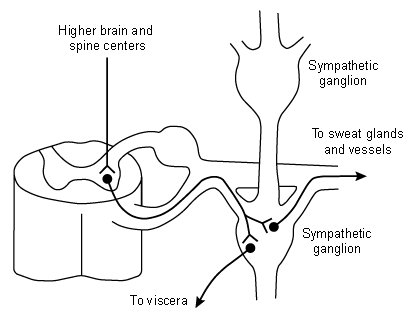Etiology
Thermoregulation and sweating are controlled by complex neurologic pathways involving the cerebral cortex, hypothalamus, and sympathetic nervous system.[2] The precise etiology of primary hyperhidrosis is not entirely clear, but it is likely to be a result of overreactivity or hyperexcitability of the neurologic circuits causing sweating. Although the simplest explanation is hyperactivity of the sympathetic nervous system, it is likely to be more complex, involving interactions between the sympathetic system, the parasympathetic system, and higher centers. The strong familial pattern of palmar hyperhidrosis suggests a hereditary predisposition.[6] The disorder appears to be an autosomal dominant trait with variable penetrance, and estimates are that a child born to a parent with the classic pattern has a 1 in 4 chance of having the disorder as well, but with a wide range of expression. Genetic analysis has mapped the palmar variety to chromosome 14.[7] However, the genetic locus for the axillary or facial subsets of hyperhidrosis is not clear.[6][7] Secondary hyperhidrosis is due to an organic etiology, such as an endocrine, a neoplastic, or an infectious cause.[Figure caption and citation for the preceding image starts]: Schematic drawing showing the relationship of the central nervous system to the sympathetic ganglia and peripheral and visceral targetsFrom the personal collection of Fritz Baumgartner, MD [Citation ends].
Pathophysiology
Humans have approximately 3 million sweat glands distributed over the body surface, with a higher concentration on the palms, forehead, soles, and axillae.[2][11] Of the 3 types of sweat glands, the eccrine type is the most prevalent and clinically most significantly relevant to hyperhidrosis syndromes. Apocrine and apoeccrine sweats are less significant but may also be involved in axillary sweating. Patients with hyperhidrosis do not have any abnormalities in the number or histology of the eccrine sweat glands, nor is there any apparent histologic abnormality of the sympathetic nervous fibers or ganglia in affected patients. The pathophysiology involves a more elusive and complex hyperexcitability of the neurologic pathways, which is likely to involve cortical, hypothalamic, and autonomic nervous system interactions. The pathophysiology of secondary hyperhidrosis involves the systemic and neurologic effects of organic disorders and ultimately their effect on thermoregulatory centers in the hypothalamus.
Classification
Primary hyperhidrosis[1]
Palmoplantar hyperhidrosis
Excessive hand sweating (palmar hyperhidrosis) to the point of dripping or near dripping. The soles of the feet may be equally affected (plantar hyperhidrosis).
Axillary hyperhidrosis
Excessive underarm sweating that is not synonymous with underarm malodor. It is much more varied in severity, etiology, and patient impact than palmar or plantar hyperhidrosis.
Craniofacial hyperhidrosis
Excessive head sweating, primarily of the face. It can be disabling for patients in its severe form.
Secondary hyperhidrosis
Excess sweating due to specific pathologies, including endocrine, infectious, neoplastic, cardiovascular, drug, or toxicological causes. It can also result from a neurologic injury. Because these disorders are readily suspected following a thorough history and physical exam, it is usually a simple matter to distinguish secondary from primary hyperhidrosis.
Hyperhidrosis Disease Severity Scale by the International Hyperhidrosis Society[2]
The severity of the hyperhidrosis, as judged by the level of impairment of the activities of daily living, can be assessed with the 4-point Hyperhidrosis Disease Severity Scale:
Level 1 is nonsignificant sweating that does not interfere with the activities of daily living.
Level 2 is tolerable sweating that sometimes interferes with the activities of daily living.
Level 3 is barely tolerable and frequently interferes with the activities of daily living.
Level 4 is intolerable and always interferes with the activities of daily living.
Use of this content is subject to our disclaimer